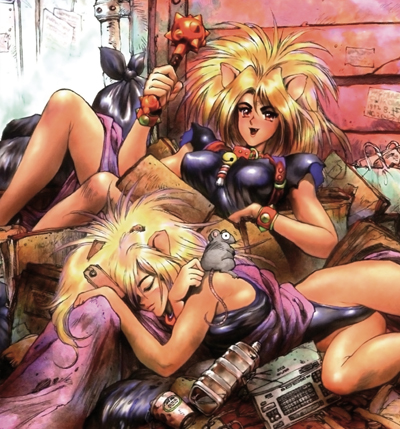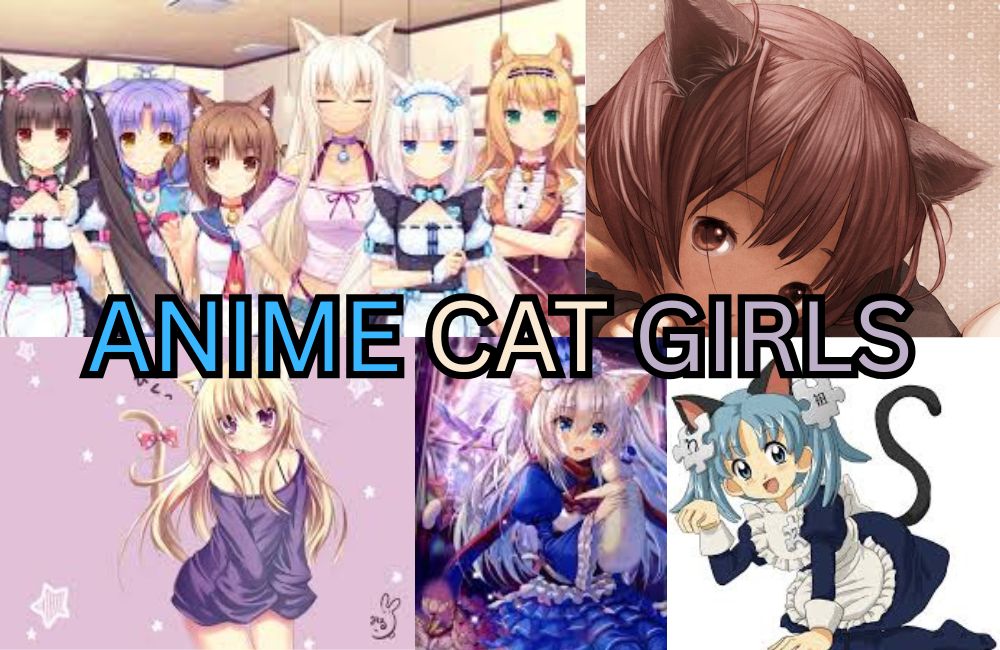The explosion of Anime came with the popularity of cat girls. These animalistic feline females have garnered the appreciation of fictional girls with cat traits. How could the mixture of cats with females be popular across the globe, and who are the most recognizable girls or women with the nekomimi?
Understand the appeal of anime cat girls with this comprehensive guide on this type of fictional character below.
What Are Anime Cat Girls?
Anime cat girls, or nekomimi, blend human characters with clear feline cues. The result is a readable, expressive design that audiences recognize in a second. You’ll see them across genres, art styles, and age ratings.
Nekomimi literally means cat ears. In practice, the term covers characters who keep a human body while showing feline traits. Ears sit high on the head and tilt or flick to signal emotion. A tail adds balance and rhythm to movement.
Eyes may narrow, widen, or suggest slit pupils under certain lighting. Tiny fangs, whisker marks, and soft paw motifs appear in some designs. Animators use ear twitches, head tilts, stretching, and quick starts to convey curiosity and play. You’re meant to read feelings fast, even in a crowded frame. The language is simple, iconic, and easy to stylize.
Kemonomimi vs Nekomimi
Kemonomimi is the umbrella term for human characters that feature animal-like traits. It includes fox, wolf, rabbit, dog, and other hybrids. Nekomimi is the cat-specific subset. Traits lean on lightness, agility, quiet footwork, and expressive balance. Designers pick cat ears with triangular silhouettes and smooth fur rendering.
Tails often curve in S-shapes that read at a distance. Fox or wolf designs push length, fluff, and predatory weight. Rabbit designs emphasize long ears and jump posture. Cat girls occupy the middle ground between cute and sleek. That’s why they fit comedy, drama, and action without a redesign.
Why They’re Popular
Anime cat girls communicate emotion with near-zero dialogue. Ears rise to show interest. They fold to show fear or shame. Tails switch from relaxed curves to sharp angles when tension climbs. This clarity helps storytellers pace scenes without taking up too much manga panels or anime scenes.
The trope also bridges audiences. Children read the cues as playful. Teens and adults read them as stylish or cool. The look scales from slice-of-life to sci-fi and fantasy with minor tweaks. Artists love the silhouette. Cosplayers love the modular gear and comfort. Brands love the instant recognition on thumbnails, covers, and merch.
Classic Archetypes
Three archetypes frequently appear because they address common story needs.
- Energetic sidekick. Brings motion and levity. Quick reflexes, big smiles, and fast recoveries keep scenes bright. Merle from Vision of Escaflowne is a perfect example who lightens the mood after Van’s fights.
- Aloof guardian. Competent and calm. Neutral ears, steady gaze, and efficient movement signal control. Yoruichi and Bagi are good examples.
- Mischievous foil. Adds conflict without cruelty. Practical jokes, secret snacks, and vanishing acts reveal other characters. Shampoo fits this archetype as the cute antagonist for Ranma.
Origins and Evolution
Where did the anime cat girls come from, or why are they well known in Japan. Here are some historical facts on the nekomimi onnas and how modern culture shaped them:
Folklore Roots
Nekomimi ideas trace to Japan’s yōkai lore. The bakeneko and nekomata were shapeshifting cats linked with mystery, mischief, and twilight power. Stories described split tails, human speech, and protective or vengeful roles.
Artists later distilled those traits into visual shorthand. Upright ears signal alertness. S-curved tails imply intent. Night vision and silent steps hint at the supernatural without breaking realism.
These mythic notes shaped modern character cues and body language. They also explain why nekomimi read as charming yet uncanny. The balance of cute and otherworldly still anchors anime cat girls in popular imagination.
Early Manga and Anime
Cat traits moved into mainstream design as creators searched for quick, legible emotion. Triangular ears and a mobile tail gave animators instant mood signals. Comedic shorts used ear flicks for punchlines.
Action scenes used tails to stage balance and agility. Mascot helpers, magical companions, and idol side characters made the silhouette familiar to broad audiences. Merchandise reinforced the look through headbands and plush figures. Over time, studios varied styles, from round, soft ears to sleek, sharp sets. The toolkit stayed consistent. That stability kept anime cat girls recognizable across decades and genres.
Global Spread
Localization, fan clubs, and conventions carried the trope worldwide. Cosplayers refined wigs, ear headbands, and clip-in tails that survive a full con day. Western comics and games borrowed the silhouette for speed, stealth, and charisma. VTubers and streamers amplified the appeal with reactive ear physics and playful voice work. Social platforms pushed tutorials that made crafting accessible.
The result is a shared design language that crosses borders with ease. Fans can spot it at a glance and remix it for any setting. Recognized traits keep anime cat girls visible in art trades, indie games, and mainstream releases.
Notable Appearances in Anime and Manga
Cat girls became widely popular in the 90s for a good reason. Hit animes like Outlaw Star, Vision of Escaflowne, and the OVA Darkstalkers gave us some of the best feline characters in Japanese media. Their popularity also made many aware of older movies that featured cat girls. Here are the most popular ones anime fans are familiar with:
Felicia — Darkstalkers / Night Warriors OVA.
The cat girl monster of Darkstalkers made a splash in the arcades with her feline design. Felicia’s moves also take advantage of her cat traits such as kicking sand onto her opponent.

Neferpitou — Hunter × Hunter
A Chimera Ant Royal Guard with feline ears, tail, and predatory curiosity. Uses Nen for terrifying precision and support, including Doctor Blythe and puppet-like control. Cute mannerisms mask ruthless loyalty and monstrous power.

Bagi — Bagi, the Monster of Mighty Nature
An Osamu Tezuka human–cat hybrid created by genetic experimentation. Agile, alert, and torn between instinct and conscience. Her arc probes identity, ethics, and the roots of nekomimi design in modern media.

The Puma Sisters (AnnaPuma and UniPuma) — Dominion Tank Police
Android catgirls styled for speed and spectacle. They are made to be lovedolls and bodyguards, which is reflected through their mature design. Their cyberpunk look helped cement high-contrast ears, tails, and sleek silhouettes in sci-fi aesthetics.

Yoruichi Shihōin — Bleach
A mature mentor with a full cat transformation rather than just ears and a tail. Yoruichi is a master of Shunkō. Her personality is a balance between wit and elite discipline, showing how feline traits can signal speed, stealth, and authority.
Shampoo — Ranma ½
A Chinese Amazon warrior cursed to turn into a cat with cold water. Energetic, competitive, and fiercely devoted. While Shampoo is not a nekomimi ona, her behaviour is similar to a cat’s capricious behavoir.
Tsubasa Hanekawa — Monogatari Series
A studious girl whose stress manifests as the bakeneko “Black Hanekawa.” White hair, ears, and tail mark the alter ego. The story uses feline traits to explore repression, boundaries, and hard-won self-understanding for Hanekawa.
Are Cat Girls Considered Furries?
Yes, they are considered furries. By its definition, anthropomorphic characters have animal traits. Cat girls are always considered anthro given the ears, tail, and other minor details (whiskers and cat eyes.)
This argument stems from the word “furries,” where a character should be covered in fur and is a bipedal version of a cat. Bagi fits the bill among the anime cat girls I listed above. The furry community and anime fans tend to agree that anime cat girls who only have minor animal traits are of the nekomimi archetype. Do you agree that cat girls are also furries? Let us know in the comments below.
Popularity of Anime Cat Girls
The archetype of anime cat girls makes them a popular addition to any story. Their quirky and cheerful personality makes them a good contrast to the protagonist or other main characters. Artists also have fun drawing them in modern settings or fantasy universes by matching their cat traits to their clothes as well as making them do cat poses.
Their global popularity has led to many vTubers adopting the cat girl traits to their models. Chances are also high you will find nekomimis and cat paws within anime cosplay shops or those who sells Japanese merchandise.
Thank you for reaching the end of my article. Let us know if you have a favorite cat girl you want to talk about in the comments below. Read this article to know more about anime girls and their impact to global media.



